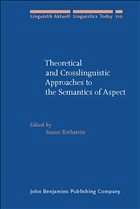Nicht lieferbar

Theoretical and Crosslinguistic Approaches to the Semantics of Aspect
Versandkostenfrei!
Nicht lieferbar
The papers in this volume investigate the semantics of aspect from both a theoretical and cross linguistic point of view, in a wide range of languages from a number of different language families. The papers are all informed by the belief that a thorough exposure to the expression of aspect cross-linguistically is crucial for progess in understanding how the semantics of aspect and what the semantic basis of aspectual distinctions is. The languages discussed include Russian, English, Dutch, Hebrew, Mandarin, Japanese and Kalaallisut. The issues discussed in this volume include the centrality o...
The papers in this volume investigate the semantics of aspect from both a theoretical and cross linguistic point of view, in a wide range of languages from a number of different language families. The papers are all informed by the belief that a thorough exposure to the expression of aspect cross-linguistically is crucial for progess in understanding how the semantics of aspect and what the semantic basis of aspectual distinctions is. The languages discussed include Russian, English, Dutch, Hebrew, Mandarin, Japanese and Kalaallisut. The issues discussed in this volume include the centrality of measuring and counting in an understanding of telicity; the importance of the singular/plural distinction in the study of aspect, the importance of homogeneity as a property of event types, the flexibility of lexical classes, and the interaction between expressions of aspect and the particular morphosyntactic structure of a language.
Table of contents:
- Introduction
- Part I. Tense, aspect and Vendler classes
- 1. Lexicalized meaning and the internal temporal structure of events
- 2. Telicity, atomicity and the Vendler classification of verbs
- 3. Aspects of a typology of direction
- 4. 1066: On the differences between the tense-perspective-aspect systems of English and Dutch
- 5. Tenses for the living and the dead: Lifetime inferences reconsidered
- Part II. Issues in Slavic aspect
- 6. Formal and informal semantics of telicity
- 7. Events and maximalization: The case of telicity and perfectivity
- 8. Aspect and bounded quantity complements in Russian
- 9. Negation, intensionality, and aspect: Interaction with NP semantics
- Part III. Aspect in non-Indoeuropean languages
- 10. Habituality and the habitual aspect
- 11. Aspectual universals of temporal anaphora
- 12. The syntax and semantics of change/transition: Evidence from Mandarin Chinese
- 13. Bare nouns and telicity in Japanese
Table of contents:
- Introduction
- Part I. Tense, aspect and Vendler classes
- 1. Lexicalized meaning and the internal temporal structure of events
- 2. Telicity, atomicity and the Vendler classification of verbs
- 3. Aspects of a typology of direction
- 4. 1066: On the differences between the tense-perspective-aspect systems of English and Dutch
- 5. Tenses for the living and the dead: Lifetime inferences reconsidered
- Part II. Issues in Slavic aspect
- 6. Formal and informal semantics of telicity
- 7. Events and maximalization: The case of telicity and perfectivity
- 8. Aspect and bounded quantity complements in Russian
- 9. Negation, intensionality, and aspect: Interaction with NP semantics
- Part III. Aspect in non-Indoeuropean languages
- 10. Habituality and the habitual aspect
- 11. Aspectual universals of temporal anaphora
- 12. The syntax and semantics of change/transition: Evidence from Mandarin Chinese
- 13. Bare nouns and telicity in Japanese




